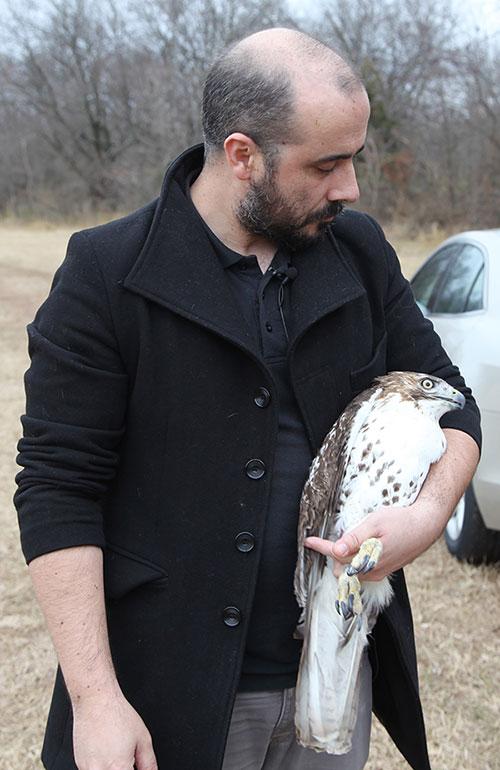
Returning Lucy to the Wild
Friday, January 12, 2018
Members of the Oklahoma State University Police Department and Dr. Bruce Crauder, associate dean for instruction and personnel at the College of Arts and Sciences, recently assisted OSU’s Center for Veterinary Health Sciences with a red tailed hawk release. Dr. Crauder had previously brought injured wildlife to the center’s Veterinary Medical Hospital for care while the OSU PD had brought this particular bird to the Hospital.
“She was found next to the police station,” explained Dr. João Brandão, assistant professor of zoological medicine at the Hospital. “She might have been hit by a car; we’re not sure what happened. She was moving her wings but she was not moving her legs.”
The hawk spent a few days in the Hospital receiving IV fluids and pain medication.
“We took x-rays. There was nothing significant that we could find,” continued Brandão. “We assume she had some kind of spinal trauma. We gave her pain medication, anti-inflammatories and we also did acupuncture to see if that would help with the recovery. She did very well. She was using her legs and once she was considered to be okay, we placed her in one of our flight cages. She was there for a couple weeks to exercise her flight and give her time to build up some of the body mass that she may have lost. The muscle goes away if they don’t exercise.”
Brandão and his team also placed a federal band on one of the hawk’s legs. If the bird is found again and reported, helpful information can be collected such as how far she traveled, how long she survived, etc.
“These animals eat a variety of prey,” continued Brandão. “The size of their talons and the strength of their feet are quite impressive. On top of that, they also use the beak to open the prey and to help them eat. These are relatively decent sized birds. You can see the extension of the wing span of just one of them (as he spreads the hawk’s wing out). They are much bigger than what they seem when they are flying.”
Dr. Brandão went on to explain that they do not name wildlife when they have them in captivity for treatment.
“We do not want to get attached to them. They are not a pet; they’re a wild animal,” he said. “They have a number and that’s about it. When we are releasing them, we do try to name them.”
Brandão solicited the help of the police officers who found the bird to name her. They selected “Lucy” as her name. He stood between one of the officers and Crauder and on the count of three, Lucy was set free.
OSU’s Veterinary Medical Hospital treats approximately 500 wildlife cases a year. If you would like to help support the veterinary medical treatment of Oklahoma’s wildlife, please contact Chris Sitz, senior director of development, at csitz@osugiving.com or 405-385-5170.
Contact: Taylor Bacon | Public Relations and Marketing Coordinator | 405-744-6728 | taylor.bacon@okstate.edu
